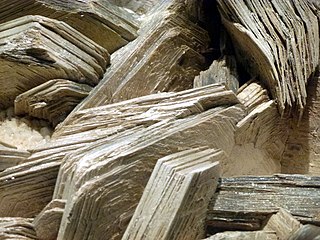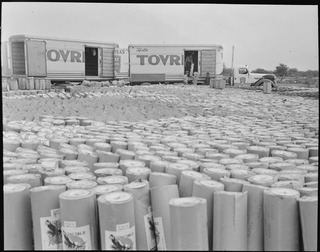
A book is a medium for recording information in the form of writing or images, typically composed of many pages bound together and protected by a cover. The technical term for this physical arrangement is codex. In the history of hand-held physical supports for extended written compositions or records, the codex replaces its predecessor, the scroll. A single sheet in a codex is a leaf and each side of a leaf is a page.

Lithography is a method of printing originally based on the immiscibility of oil and water. The printing is from a stone or a metal plate with a smooth surface. It was invented in 1796 by German author and actor Alois Senefelder as a cheap method of publishing theatrical works. Lithography can be used to print text or artwork onto paper or other suitable material.
Mass deacidification is a term used in library and information science for one possible measure against the degradation of paper in old books, the so-called "slow fires". The goal of the process is to increase the pH of acidic paper on a large scale. Although acid-free paper has become more common, a large body of acidic paper still exists in books made after the 1850s because of its cheaper and simpler production methods. Acidic paper, especially when exposed to light, air pollution, or high relative humidity, yellows and becomes brittle over time. During mass deacidification an alkaline agent is deposited in the paper to neutralize existing acid and prevent further decay.

A mimeograph machine is a low-cost duplicating machine that works by forcing ink through a stencil onto paper. The process is mimeography. A copy made by the process is a mimeograph.

Micas are a group of minerals whose outstanding physical characteristic is that individual mica crystals can easily be split into extremely thin elastic plates. This characteristic is described as perfect basal cleavage. Mica is common in igneous and metamorphic rock and is occasionally found as small flakes in sedimentary rock. It is particularly prominent in many granites, pegmatites, and schists, and "books" of mica several feet across have been found in some pegmatites.

Printmaking is the process of creating artworks by printing, normally on paper. Printmaking normally covers only the process of creating prints that have an element of originality, rather than just being a photographic reproduction of a painting. Except in the case of monotyping, the process is capable of producing multiples of the same piece, which is called a print. Each print produced is considered an "original" work of art, and is correctly referred to as an "impression", not a "copy". Often impressions vary considerably, whether intentionally or not. The images on most prints are created for that purpose, perhaps with a preparatory study such as a drawing. A print that copies another work of art, especially a painting, is known as a "reproductive print".
Sizing or size is a substance that is applied to, or incorporated into, other materials—especially papers and textiles—to act as a protective filler or glaze. Sizing is used in papermaking and textile manufacturing to change the absorption and wear characteristics of those materials.

Acid-free paper is paper that if infused in water yields a neutral or basic pH. It can be made from any cellulose fiber as long as the active acid pulp is eliminated during processing. It is also lignin- and sulfur-free. Acid-free paper addresses the problem of preserving documents and preserving artwork for long periods.

Intaglio is the family of printing and printmaking techniques in which the image is incised into a surface and the incised line or sunken area holds the ink. It is the direct opposite of a relief print, where the parts of the matrix that make the image stand above the main surface.

The size of a book is generally measured by the height against the width of a leaf, or sometimes the height and width of its cover. A series of terms is commonly used by libraries and publishers for the general sizes of modern books, ranging from folio, to quarto (smaller) and octavo. Historically, these terms referred to the format of the book, a technical term used by printers and bibliographers to indicate the size of a leaf in terms of the size of the original sheet. For example, a quarto historically was a book printed on a sheet of paper folded twice to produce 1 leaf, each leaf one fourth the size of the original sheet printed. Because the actual format of many modern books cannot be determined from examination of the books, bibliographers may not use these terms in scholarly descriptions.

Tracing paper is paper made to have low opacity, allowing light to pass through. It was originally developed for architects and design engineers to create drawings which could be copied precisely using the diazo copy process; it then found many other uses. The original use for drawing and tracing was largely superseded by technologies which do not require diazo copying or manual copying of drawings.
Thioesterases are enzymes which belong to the esterase family. Esterases, in turn, are one type of the several hydrolases known.

Neurophysin II is a carrier protein with a size of 19,687.3 Da and is made up of a dimer of two virtually identical chains of amino acids. Neurophysin II is a cleavage product of the prepro-vasopressin. It is a neurohypophysial hormone that is transported in vesicles with vasopressin, the other cleavage product, along axons, from magnocellular neurons of the hypothalamus to the posterior lobe of the pituitary. Although it is stored in neurosecretory granules with vasopressin and released with vasopressin into the bloodstream, its biological action is unclear. Neurophysin II is also known as a stimulator of prolactin secretion.
The Brittle Books Program is an initiative carried out by the National Endowment for the Humanities at the request of the United States Congress. The initiative began officially between 1988 and 1989 with the intention to involve the eventual microfilming of over 3 million endangered volumes.

Paper is a thin sheet material produced by mechanically and/or chemically processing cellulose fibres derived from wood, rags, grasses or other vegetable sources in water, draining the water through fine mesh leaving the fibre evenly distributed on the surface, followed by pressing and drying. Although paper was originally made in single sheets by hand, almost all is now made on large machines—some making reels 10 metres wide, running at 2,000 metres per minute and up to 600,000 tonnes a year. It is a versatile material with many uses, including printing, packaging, decorating, writing, cleaning, filter paper, wallpaper, book endpaper, conservation paper, laminated worktops, toilet tissue, currency and security paper and a number of industrial and construction processes.
Wasli, also referred to as wasli paper, is a type of handmade paper used specifically for painting miniatures. It was devised in India, in the 10th century, and figures widely in Mughal-era painting.

Parchment paper, baking paper, liners or bakery release paper is cellulose-based paper that has been treated or coated to make it non-stick. It is used in baking as a disposable non-stick surface. It should not be confused with wax paper or waxed paper, which is paper that has been coated in wax.

Red rosin paper is a 100% recycled heavy duty felt paper used in construction such as underlayment under flooring and siding. The name "rosin-sized sheathing paper", commonly used to describe the material, comes from the rosin used in the paper, the process of sizing it to add the rosin, and its use by builders. "Alum-rosin size was invented by Moritz Friedrich Illig in Germany in 1807..." and is known to have been used as a building paper by 1850.

The conservation and restoration of books, manuscripts, documents and ephemera is an activity dedicated to the preservation and protection of items of historical and personal value made primarily from paper, parchment, and leather. When applied to cultural heritage, conservation activities are generally undertaken by a conservator. The primary goal of conservation is to preserve the lifespan of the object as well as maintaining its integrity by keeping all additions reversible. Conservation of books and paper involves techniques of bookbinding, restoration, paper chemistry, and other material technologies including preservation and archival techniques.

1cP-LSD is an acylated derivative of lysergic acid diethylamide (LSD), which has been sold as a designer drug. In tests on mice it was found to be an active psychedelic with similar potency to 1P-LSD.














